Reader David Parrish writes:
The 6.5 Creedmoor has gained a lot of converts over the last couple of years and it’s easy to see why. It promises light recoil and long-range accuracy out to 1000 yards and beyond with minimal investment. The history of the round is brief, having only come into existence in 2007.
The .264 diameter bullet, however, is used in many other cartridges like the .264 Winchester Magnum, 6.5-55mm Swedish, .260 Remington, 6.5 Grendel as well as several others. And now the increasingly popular6.5 CM. With the .308 Winchester as a parent case and the availability of brass this is going to be a great reloading cartridge.
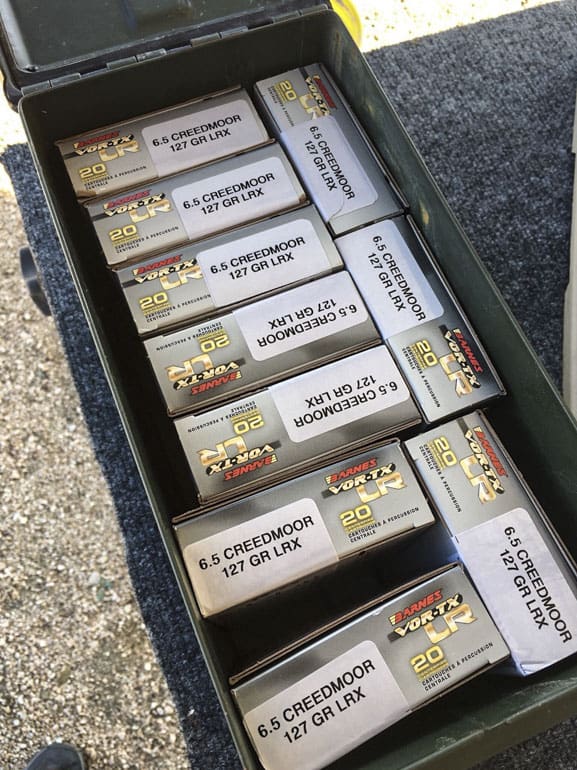
The people at Barnes have been very helpful through the field testing and evaluation process. During my talks with them, I wanted to put their proposed ammo for the shelves through some field-testing. I intended to run 100-yard groups through various rifles as well as doing some long range hunting.
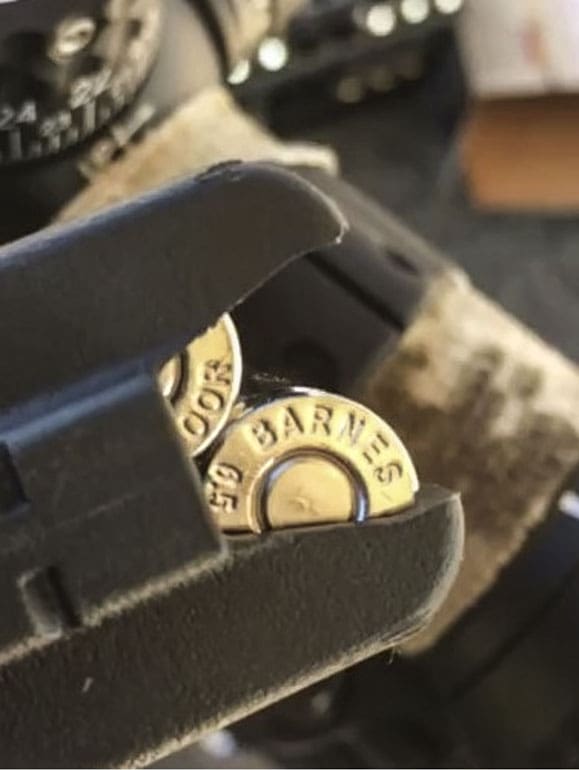
I realize “long range” means different things to different people. For me, that’s 500 yards and up. Barnes agreed and sent me several boxes of box-fresh VOR-TX LR Rifle ammo for some real world shooting.
I’ve reloaded using Barnes bullets in everything from 204 Ruger, 300 Blackout/Whisper, 6.8 SPC II, 308, 338 Lapua and on into the big bore rifles like the 416, 505 Gibbs and the .577 Nitro Express with very good results. I intended to add 6.5 CM LRX to the mix, but would it perform?
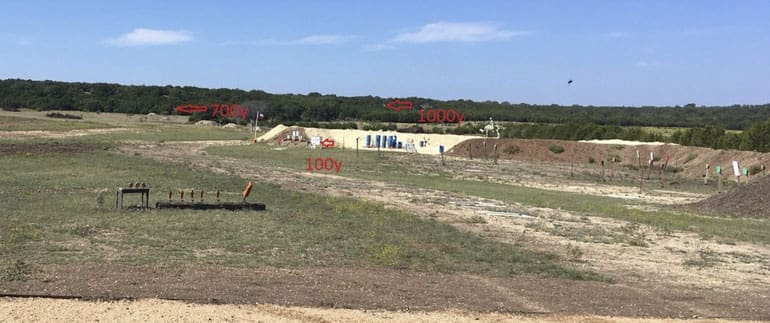
I chose the Kian Vista Ranch in Lometa, Texas for my testing. With steel and paper targets out to two miles, I knew I’d have no problem stretching the limits of these rounds, the rifles and my own limited skills. The KVR is also a fabulous ranch for hunting a range of species of native game, exotics, pigs and, of course, Whitetail deer. So I knew the Barnes 6.5 CM would see some serious field action.
I used a LabRadar chronograph to record the series of shots made from the bench. The rifles used in this volley of hellfire included a Ruger Predator Model 6973, Ruger Precision Rifle Gen 2, Horizon Firearms Custom and the Desert Tech SRS-A1.
All are fantastic rifles in their own right but this exercise was about putting Barnes Bullets through its paces on different platforms and reading the tealeaves at the end. To make the testing consistent, each rifle is topped with its own Nightorce ATACR MOA-T 5-25×56 scope (thanks to Mike at Mile High Shooting in Colorado for getting us the scopes so quickly).
| Rifle | Model | Action | Barrel length |
Twist | # lands | type lands | Overall Weight |
Scope |
| DesertTech | SRS-A1 | Bolt | 26 | 1:8 | 5 | l/g | 11lbs 7.2oz | NF C555 |
| Horizon | HZ | Bolt | 24 | 1:8 | 5 | l/g | 10lbs | NF C555 |
| Ruger | RPR | Bolt | 24 | 1:8 | 5R | l/g | 10lb 12.8oz | NF C555 |
| Ruger | Predator | Bolt | 22 | 1:8 | 5 | l/g | 6.6lbs | Vortex Crossfire II |
From the shooter’s point of view everything is pretty much the same with each setup and series of shooting. I made an exception with the Ruger Predator and put a Vortex Crossfire II with Vortex Hunter Rings. More on this later.
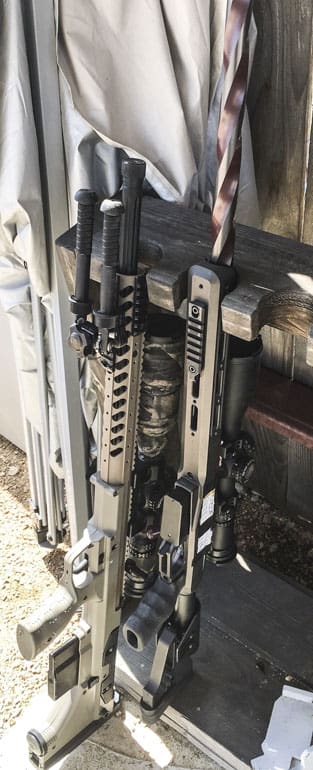
Finally, to take as much of the human parts out of this equation I used a TargetShooting.com Model 1000LP Rifle rest. The 1000LP will hold a .577 Nitro in place so the 6.5 CM was a piece of cake.

I already knew that all the rifles shoot extremely accurately, printing sub ½ MOA groups (2 with .177 and .183) at 100 yards with hand loadeds. The purpose here is to see how off-the-shelf Barnes rounds fly and hit paper, steel and feral hogs.
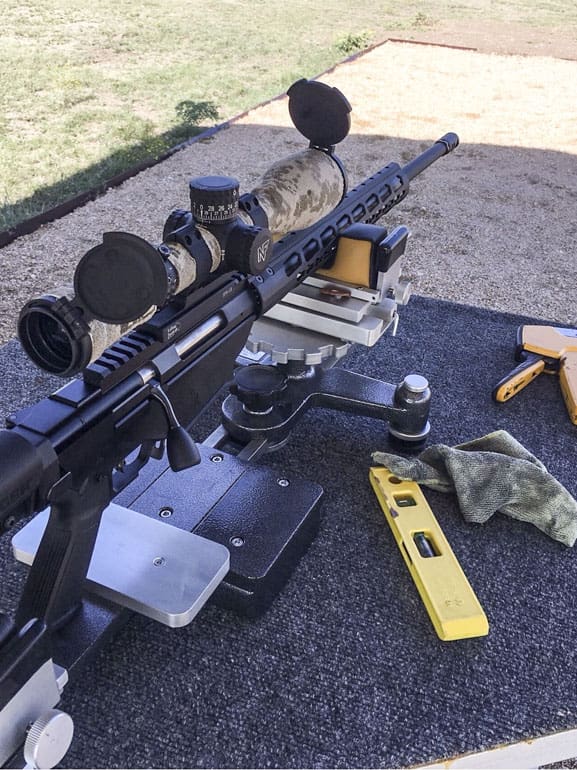
First up was the Ruger Precision Rifle Gen 2. The RPR’s extra weight really lets you ride the recoil and stay on target.

That one flyer was annoying but for a five-shot group I was happy.
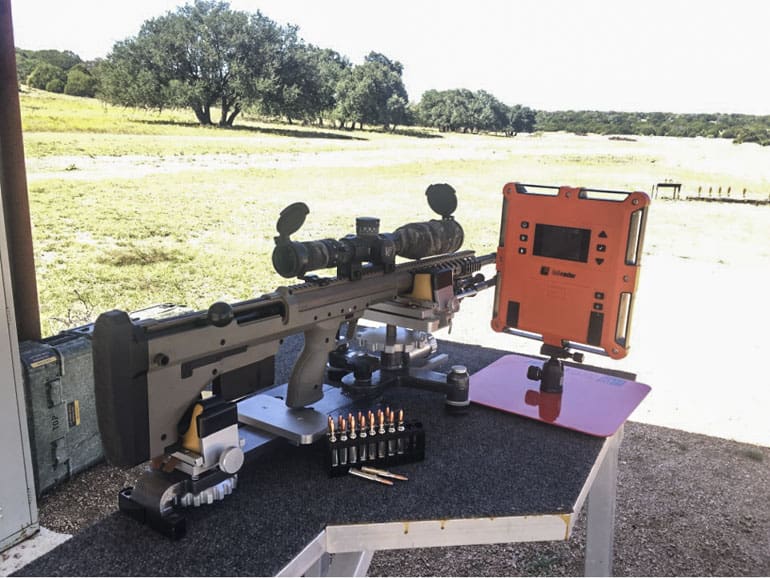
Next up was the Desert Tech SRS-A1.

Definitely an interesting pattern. As the barrel got warmer the shots drifted right. The fifth shot is the one in the middle so it did start to return to center. Normally this rifle likes a 120gr bullet and drives tacks. Note the first two rounds are very tight (those are 5/8’s in squares). Still a respectable showing of the ammunition, which is why we were there.
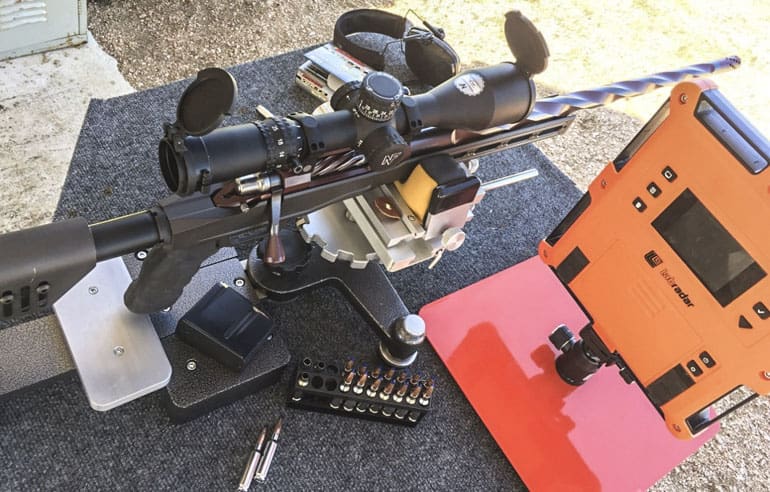
The Horizon Firearms Rifle, also known as the “Aggie Gun.”
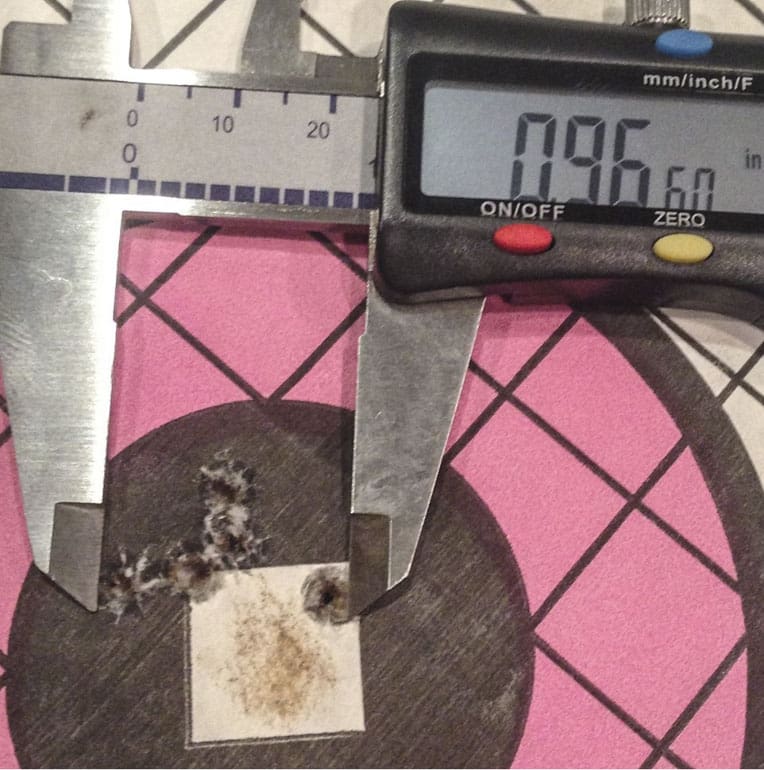
It didn’t disappoint. Solid performance from a gun that typically likes a heavier bullet in the 140-147gr. range. Again, the Barnes performed well.
| RPR | DT SRS-A1 | HRZ Custom | Predator | |
| Shot Groups | ||||
| Ftlbs Energy@Muzzle | 2173 | 2296 | 2368 | 2011 |
| Group Size In | .93 | 1.42 | .96 | .65 |
| 1 (cold bore) | 2779 | 2861 | 2937 | 2680 |
| 2 | 2782 | 2849 | 2877 | 2677 |
| 3 | 2778 | 2848 | 2854 | 2655 |
| 4 | 2771 | 2860 | 2929 | |
| 5 | 2770 | 2850 | 2894 | |
| HI | 2782 | 2861 | 2937 | 2680 |
| Low | 2770 | 2848 | 2854 | 2655 |
| Average | 2776 | 2853.6 | 2898.2 | 2670.7 |
| SD | 5.3 | 6.2 | 34.7 | 13.7 |

Finally, the Ruger Predator 6973, a rifle that’s about a quarter the price of the other three. With the Vortex Crossfire II and Vortex Hunter rings, it’s under $1000 all in.
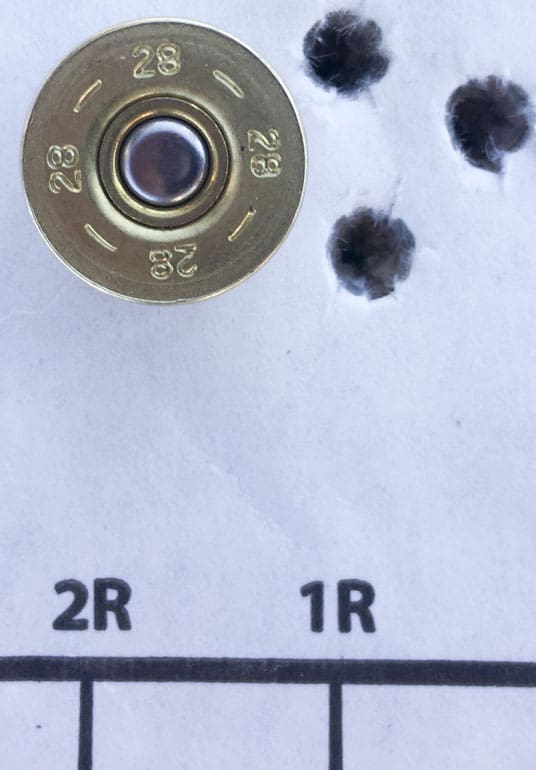
The best part is down below where stinging steel at 600 yards is not only doable but also very repeatable with the Barnes VOR-TX ammo.
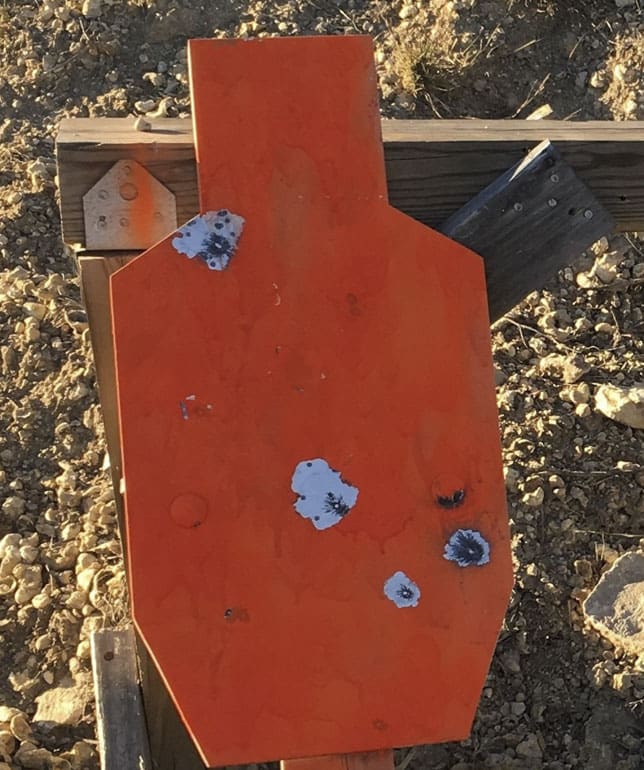
Close up of 600 yard steel. Someone tried a head shot and grazed his shoulder.

Now for the fun part. The devil is in the details.
Using the data gathered I built a quick range card from the Ballistic AE software on my phone. As always, these things must be proofed out, so that means more rounds down range. I starting at 200 yards, checked the ballistic table and adjusted the scope.
Taking aim at the six-inch steel, I squeeze one off and…PING!
What does this means for the average hunter? Once you sight in a rifle and scope to the Barnes 127grain VOR-TX LRX ammo, you put that pill exactly where we want it. Every time. Most hog and whitetail deer are harvested within 200 yards so this rifle/ammo combination became a laser beam of death for those tasty four-legged critters.
Next, a little MOA adjustment for 300 yards, another six-inch plate. PING! That beautiful sound of the VOR-TX LRX bullet slapping steel echoing back from across the range. That continued out to 700 yards with minor adjustments in the ballistic table from Ballistic AE – now that dope was ready, it was time to hit the field.
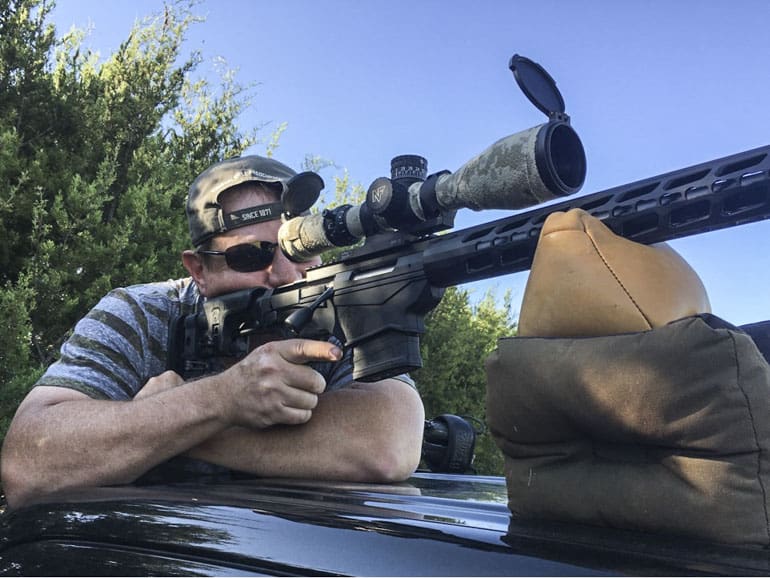
Feeling great about how the VOR-TX LRX Barnes 6.5CM was shooting in the RPR, I said “Self, what would be a great test of accuracy and precision?” The answer: blackbuck. The blackbuck at the KVR are well-feed and tasty creatures. Additionally, they present excellent long-range shooting game since they’re skittish and don’t really allow you to get closer than 200-250 yards.
With James “Devo” Devoglaer behind the wheel, we spotted a heard basking in the sun in the east field. The rangefinder indicated 250-ish yards to the closet doe, a chip shot for the VOR-TX LRX. We steadily backed up into a row of cedar trees where the rangefinder measured 450 to the closest doe.
I set up on top of the truck with a couple of stacked shooting bags and started scanning for shootable does. After a few minutes of settling in and Devo calling range and wind to the target, I settled on one that was grazing near an oak tree. She was quartering away but still a reasonable target for the kill shot.
Adjusting dope and wind. I let one fly. The 127-grain ballistic tip round traced in towards the target then with an audible THUMP on the beast my spotter called “HIT!” We watched as the animal stumble and drop.
We drove to our prey to examine the effects of the round. Just as predicted, the round entered near the left ham and exited on the opposite side just near the right lung. The beast did not suffer more than 15 seconds as evident by the blood loss. Later examination during cleaning revealed several damaged internal organs.
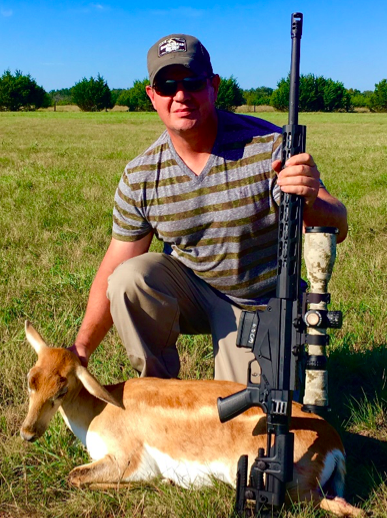
A few weeks later, it was time to get an Axis doe for our ballistic tests and of course putting meat in the freezer. My scout, guide, photographer and good friend “Devo” went with me to another ranch near the KVR for the Axis doe hunt.
In the late afternoon started to see movement in the tree line about 300 yards away when a small buck and doe emerged from the tree line. As they walked into the pasture of alfalfa a few more does stepped out, then another and another and then we saw the one. She was clearly the largest of the group and as the heard settled to eat she stood a few inches above the rest.
With the wind directly to our left we crouched and crawled away from the trees across the undulating field of tall grasses to patch of small shin oaks, about 160 yards from the herd.
I readied myself in the prone using some old fence post laying next to the trees, dialing the scope to the range given and tracking her as she moved among the herd. The herd must have been spooked a bit and they all scramble a few feet leaving her alone. Her neck and upper back are still exposed and she starts to quarter away but almost broadside now. Final range check, breath, relax, aim, squeeze…SNAP! The round entered her neck just below her head and she immediately dropped.
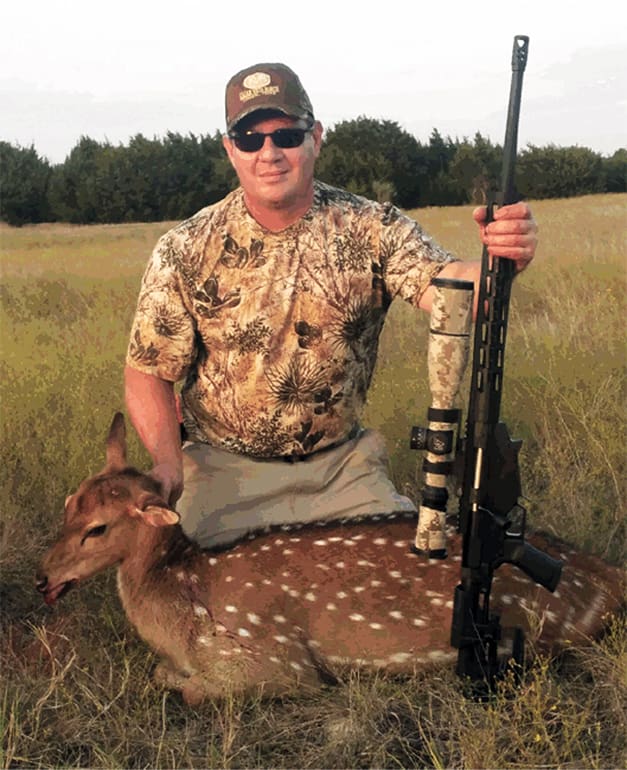
The next day, after sitting a while and watching does I was ready for a buck to come calling. Unfortunately, nothing showed up that afternoon as I watched the sun go down behind the trees. I had seen the bigger bucks on camera showing up last light so I thought I’d stick around just to see if they were still on schedule. The feeder to my left has been quiet but I thought I saw movement and turned to look through the binos and spotted…PIGS!
Here it was 30 minutes after sundown and there were at least six of them at the south feeder. Bringing my rifle to bear, adjusting parallax and setting dope for that feeder I spied a nice white and black sow. She was clearly bigger than the rest so I waited for a clean shot. BAM! The Barnes VOR-TX slammed into her and she heeled over, kicked a bit, then stopped. She weighed in at 125lbs. Perfect for making sausage!
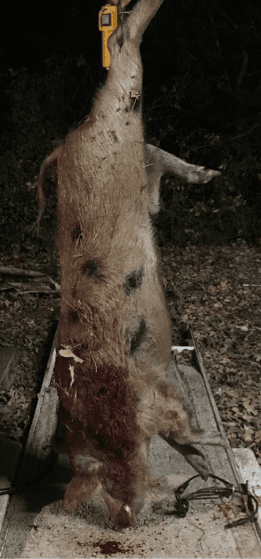
Okay, I was elated and my freezer was getting full again but I still did not have a Whitetail tag filled out yet. A few days go by and I am able to get back in my favorite stand on Ranch565 with 2 feeders in clear view as well as the creek crossing. I scanned with the Leopold LTO Tracker then my Vortex bino’s. Watching and waiting.
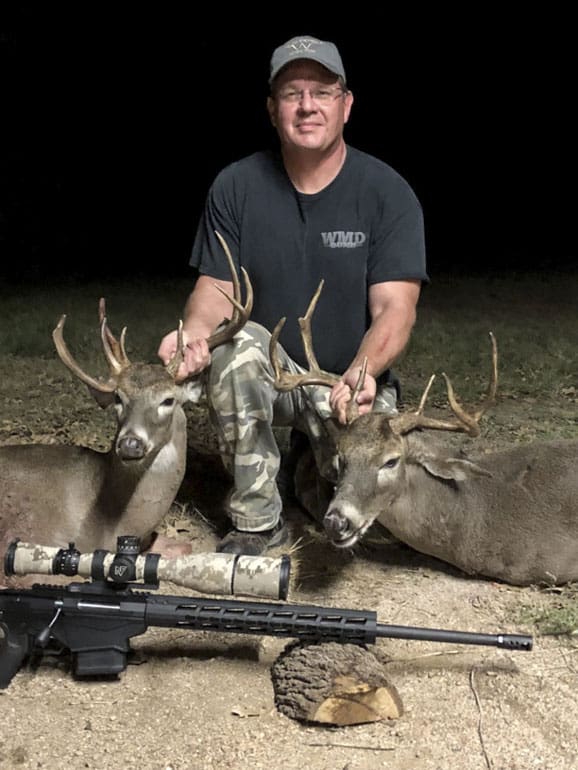
The results were just as good when the bucks made an appearance.
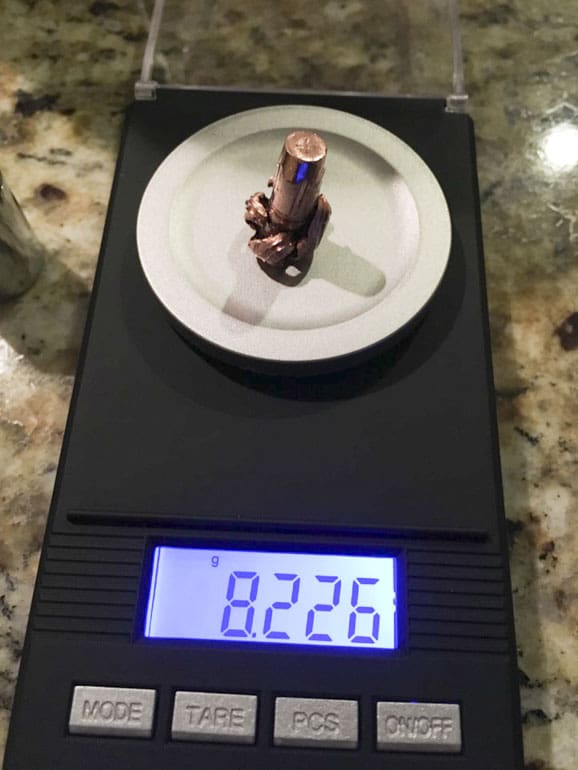
I was able to extract the bullet for later examination. It weighed in at 8.226 grams or 126.94 gains. That’s Weight retention of 99.95%. Excellent.
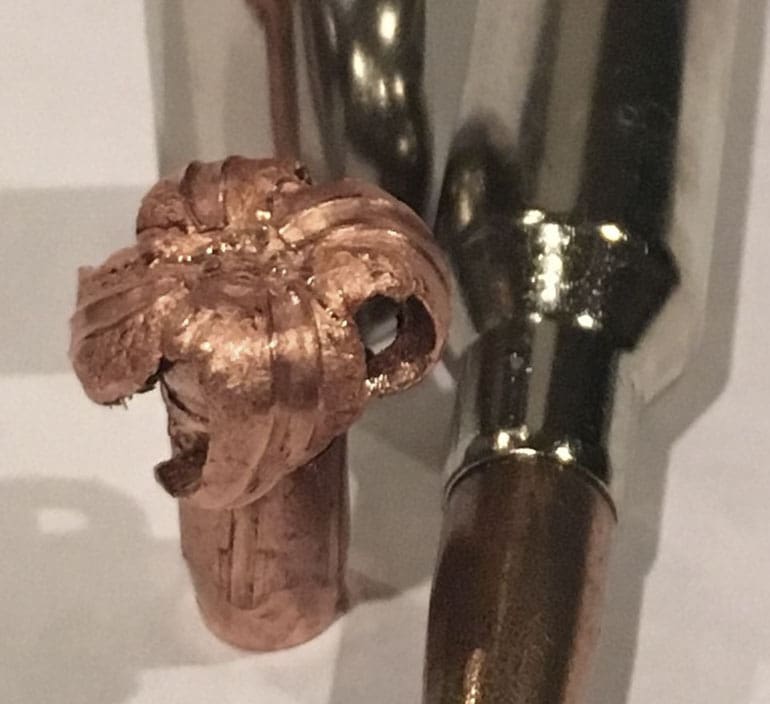
My accuracy and performance results with the Barnes VOR-TX LRX were predictable and, best of all, terminal. I have resounding confidence in their factory loads. They simply perform.
In summary, while I love to reload with Barnes the ammo they’re putting on the shelf does one hell of a job. Again, many thanks for Ryan and all the engineers at Barnes for making 2017 a great hunting year.

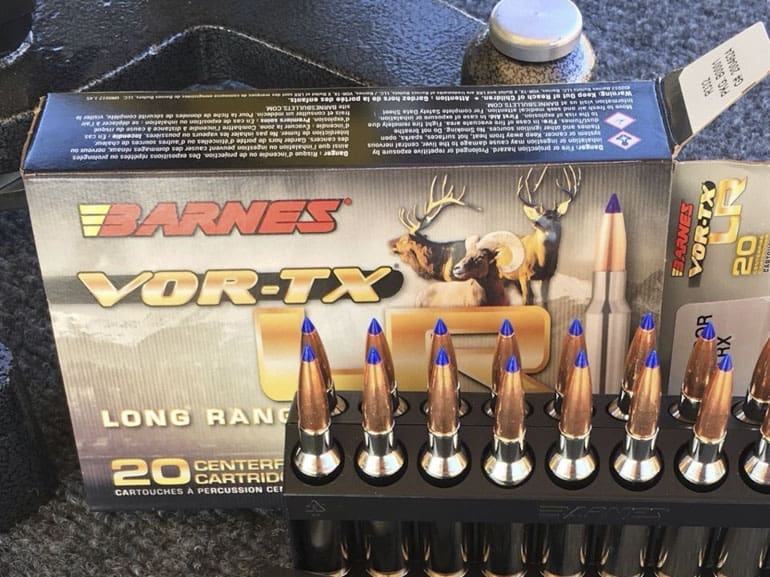



The calipers should be adjusted to point at the centers of the holes.
Appreciate the feedback. Will do next go around.
I have better luck with the 143 grain Hornady ELD-X. It’s a tad slower, but out of my two rifles, they shoot just under a half inch.
My RPR in 6.5 CM likes 130gr stuff so that Barnes 127gr I suspect will do great. Haven’t seen any yet. Where do I get it?
Should widely available now. Academy for one and others. If your local folks are not stocking Barnes tell them to get it. If you still have trouble email me directly.
Glad to hear. That was kind of my point. Believe it or not some folks don’t understand how various ammo can perform so differently in individual rifles but it does. I always advise to try all sorts of combinations to match the ammo to your rifle and to your purposes.
Great article. I hunt with Dave and shot my first buck at Ranch565 under his guidance. He ain’t a bad writer either!
The 6.5 CM is a great round of ammo. I hunt with Dave and got my second buck at Ranch 565 with him. Thanks Dave! He is a great shooter and a even better uncle!
I’m still unconvinced what advantage 6.5CM has over .260 Rem other than being 4mm shorter.
If anything, .260 is better in my opinion because brass can be made by running .308 cases through a .260 die. No shortening needed. I know someone who makes .260 cases from .308. He doesn’t even turn the necks and they are good to 1000m.
This 6.5 isn’t better, it’s new and different. People are always wanting to try new stuff and the CM is new stuff. The typical everyday shooter thinks the 6.5 CM will make them a better shooter. Sorry to disappoint but only training will make a better shooter. My advise is, pick a round suitable for the task at hand then train, train and train. Learn how your chosen round performs at all ranges and conditions then keep a data book. Really simple.
That I’d like to see! Love the 260 myself. The point I wanted to make is that as a reloader I find that Barnes did a fantastic job of putting this bullet and brass into mass production and it does really well. Combine that with a Ruger Predator and a Vortex and you have a Sub 1000$ gun shooting 1000y all day.
I shot a turkey in the neck at 375 with a 243 win…… Oh yeh, dude them rifles ain’t doing that caliber no justice
Perhaps. Probably more the shooter in this case. It is a fantastic and enjoyable caliber to shoot however. Appreciate the read and comments.
308 is not the parent case of 6.5 CM. 300 TC is
Good catch. 👍🏻 In shooting and life it’s good to be precise and accurate.
The 308 is the parent case of the .30 TC, which is the parent case of the 6.5 CM. So I guess that make the 308 the grandparent case of the 6.5 CM.
You’re exactly right, not the 7.62x51mm case, it’s the 30 TC case. Not really a huge issue but it’s best to be right. Semper Fi
My next rifle is going to be a savage model 10 in 6.5 cm. With a vortex scope. Great article and i will be trying this ammo with it.
Should be a great combination 👍🏻
You can also measure from the outside of one hole to the inside of the other hole..That will give you the center to center distance…
You’re a machinist aren’t you?
Something odd I noticed (not saying its wrong, just odd) is the muzzle velocities. The Horizon and RPR both had 24″ barrels while the DT had a 26″ barrel but the velocities between the two 24″ rifles we varied by more than 100FPS and then the Horizon rifle was also averaging about 50FPS faster than the longer 26″ DT rifle. Again I’m not saying your data is wrong but it is definitely a bit different than what one would expect. Great article though. I just bought 200 rounds of the Barnes because of this and can’t wait to get the chronography under this with my 16″ barrel. Thank you sir.
Alex, I was curious about that as well. I assumed the variations in throat and jump to lands, custom guns vs production etc. the Labdar did come out with a new firmware. It would be interesting to reshoot those rifles and see if there is any change.
Glad you got the ammo. I just ordered 2 cases myself 👍🏻🤠
I’m about to start in on the 6.5 with the127 LRXs.
In answer to other questions-
Don’t think about the grooves at all in terms of depth- they have no effect.
Barnes COAL worked for me when I did not have a way to measure by ogive or distance off of lands (in a semi auto) Later when I got the comparators and OAL guage, .050 off the lands has worked well in a couple of calibers for me as well. Barnes will put all 5 in the same hole if everything else is right.
Barnes has changed their load data for some cartridges at least 3 times, lowering the max each time. Probably their lawyers. Trust what your cases and rifle tell you regarding pressure and max loads.
Barnes bullet like to be driven fast. My most accurate loads always seem to be near max. There may be other good nodes down below, but they need speed or hard bone resistance to open up on game well, so higher MV means better expansion at farther distances.
So seat them deep and drive them hard and they will be accurate and perform.
Autopsy results- Barnes just drills them. From a 270, nickle size entry, quarter size exit, very little meat loss, all bones encountered (like shoulder of a wild 240lb boar) have a raged hole or bones like neck or spine totally disintegrated, and internal organs destroyed by hydrostatic shock. Deer and wild hogs have all dropped like a stone.